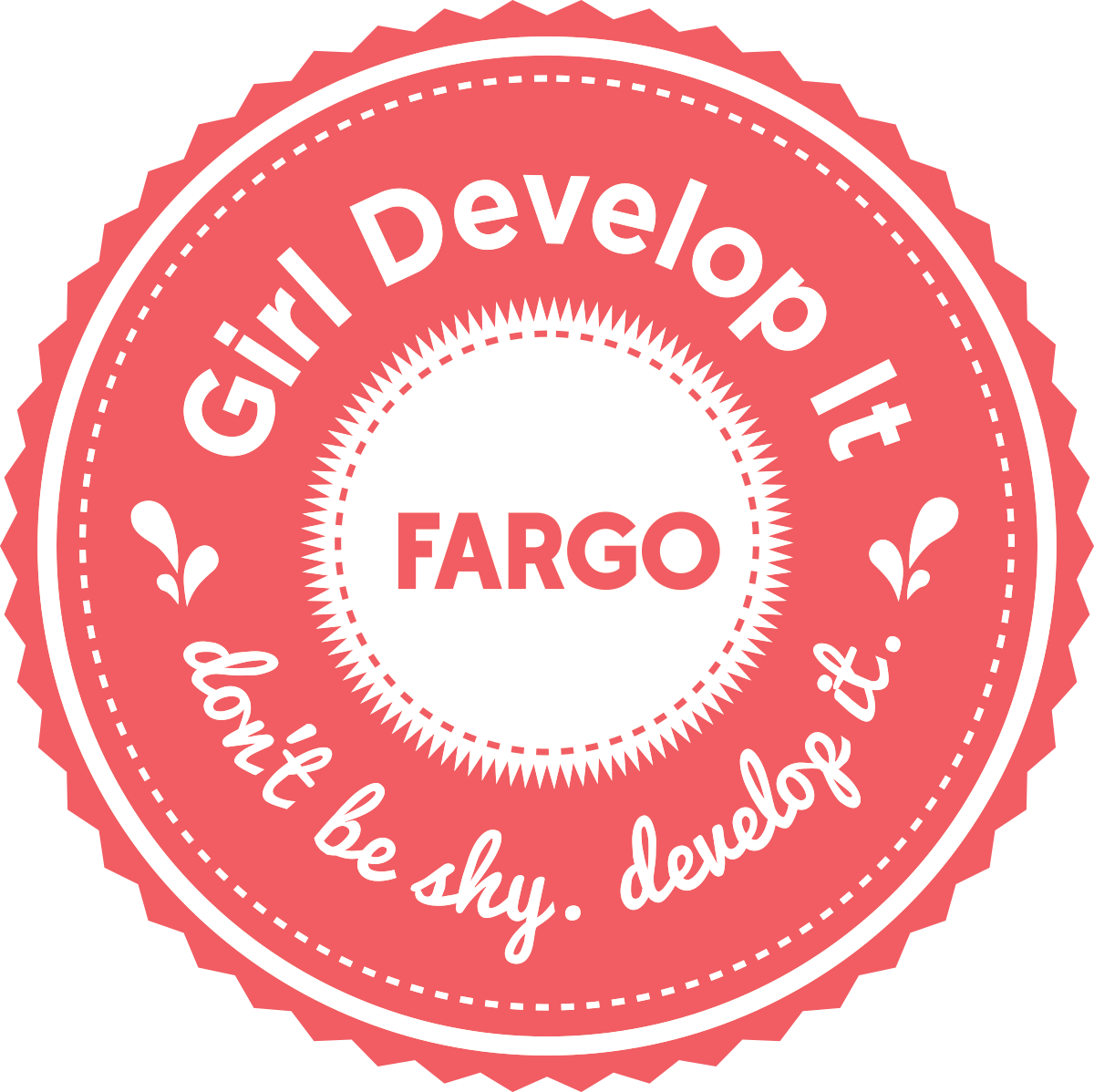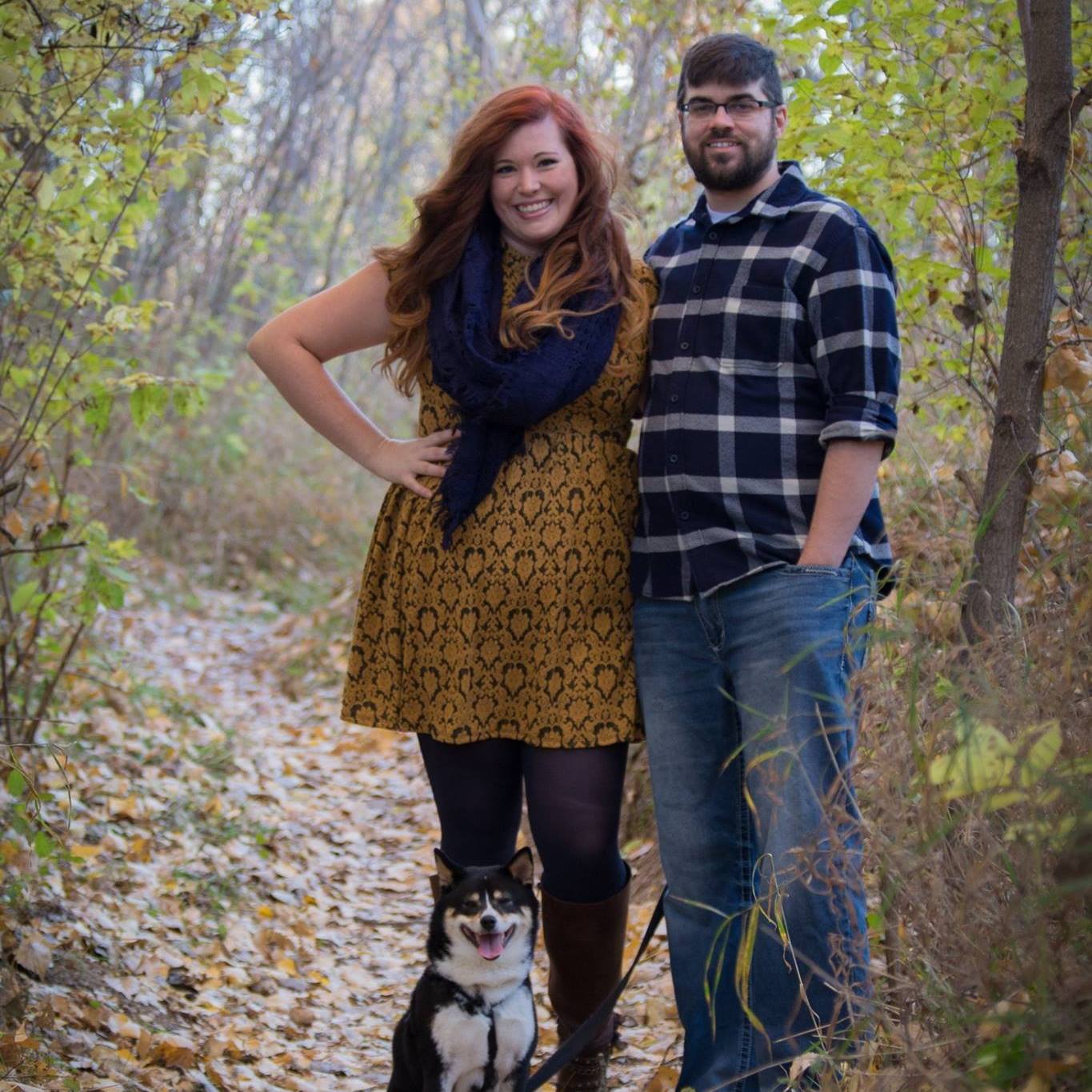
Intro to Ruby
Class 2
Welcome!
Girl Develop It is here to provide affordable programs for adult women interested in learning web and software development in a judgment-free environment.
Rules!
- We are here for you!
- Every question is important.
- Help each other.
- Have fun!
MINSWAN 
Girl Develop It is dedicated to providing a harrasment free learning experience for everyone.
For more information, see our Code of Conduct.
We're here to help!


Homework Discussion
Solution
Write a command line program that asks the user for the year they were born, then calculates their age in years, days, and seconds. Tell the user how old they are in these different formats. (Note: you'll be using gets and puts in this program, along with some math).
Solution
Temperature conversion! Make a program that asks the user for the temperature in Fahrenheit and print out the temperature in Celsius and Kelvins.
Challenge! Make these solutions better!
Review
- Math!
- Variables
- Data types: numbers (fixnum, bignum, float), strings
- Text editor, command line, and IRB
Check In
- How are you? Confused? Good! You should be. That means you are progressing.
- Programming is hard and takes time.
- My goal is to force you to code as much as possible.
- Anyone freakin' over PowerShell or Terminal? If you want to try something different, you can totally do almost everything here. Save your stuff there too!
What we will cover today
Let's do more with strings!
new_string = "The quick brown fox"
new_string[0]
string_words = new_string.split(" ")
string_words.join(" ")
Arrays
Arrays have square brackets [] and can be filled with any type of object: fixnum, strings, even other arrays or hashes.
new_array = [1, 3, 5, 89, 212, 7, -100]
arr = ["wow", "woooo", "zowie"]
array = Array.new #will have no elements inside it initially
varied_array = ["one", 2, "THREE", 0.4, ["five", 6]]
# methods to get information about an array
new_array.length
new_array.count
arr.include?("yee ha")
Arrays are a great way to keep track of information that changes frequently.
Accessing Elements in an Arrays
Arrays are ordered and are integer-indexed, starting at 0.
Elements can be accessed by their position.
new_array = [1, 3, 5, 89, 212, 7, -100]
arr = ["wow", "woooo", "zowie"]
new_array[0] # returns the zeroth element
arr[2] # returns the third element
arr[-1] # returns the last (1st from the end) element
new_array.last # returns the last element
arr.first # returns the first element
Adding & Deleting From Arrays
Adding and removing items to an array can be done in a variety of ways. These are the most common.
arr = ["wow", "woooo", "zowie"]
#add
arr.push("hot diggity") # adds argument as last element
arr << "yikes" # adds argument as last element
#remove
arr.delete("wow") # deletes the element that matches argument
arr.pop # removes and returns the last element
More Array Methods
Arrays are used a lot in Ruby.
There are a lot of cool methods available for them.
arr = ["dog", "cat", "turtle", "parakeet", "ferret"]
arr.index("dog") # returns the index of the element that matches argument
arr.join # returns a string made up of all the elements
arr.clear # removes all elements from the array
arr.reverse # returns new array with same elements, reversed
arr.shuffle # returns new array with same elements, shuffled
arr.uniq # returns a new array with only unique elements
arr.size # returns the number of elements in the array
arr.empty? # returns a boolean
arr.include?("dog") # returns a boolean
Learn more about arrays here.
Let's Develop It
Set up an array to hold the following values, and in this order: 23, 6, 47, 35, 2, 14.
Print out the average of all 6 numbers. (You can use fixnum for this exercise, which will round down your answer.)
Using the above values, have your program print out the highest number in the array.
my_array = [23, 6, 47, 35, 2, 14]
total = my_array[0] + my_array[1] + my_array[2] + my_array[3] + my_array[4] + my_array[5]
average = total/my_array.size
print "The average is " + average.to_s
print "The max is "+ my_array.max.to_s
Booleans
A boolean is a basic data type. It can have only two values
true or false
Boolean Expressions
logical statements that returns true or false
- Test for equality by using
== - Careful, remember that
=is used for assignment - Test for greater than using
> - Test for less than using
<
Boolean Expressions
a == b |
a is equal to b |
a != b |
a does not equal b |
a < b |
a is less than b |
a > b |
a is greater than b |
a <= b |
a is less than or equal to b |
a >= b |
a is greater than or equal to b |
Learn more about operators in Ruby here.
Read more about logic in Ruby here.
Boolean Expressions Practice
# try some of these out in IRB
a = 3
b = 4
a != b
a <= 3
a >= 4
a = 5
b = 5
a == b
c = a == b # Combine comparison and assignment
puts c
3 < 5
Remember: Equals does not equal "equals equals"
Further reading on boolean expressions...
Boolean Expressions
A boolean expression evaluates to true or false. It can also have multiple parts, joined by AND (&&) or OR (||).
| EXPRESSION | EVALUATES TO |
|---|---|
true && true |
true |
true && false |
false |
false && false |
false |
true || true |
true |
true || false |
true |
false || false |
false |
not (true && false) |
true |
Further practice on boolean expressions...
Let's Develop It
Take a few minutes and experiment with boolean expressions in IRB. You can start with the examples below.
true && false
1 == 1 && 2 > 37
"boop" == "bip" || 7 == 8
false || true
89 > 88 || 89 < 90
true || not(1 == 1 || 2 == 65)
Remember, the comparision methods are not giving us the strings 'true' and 'false'; they are giving us special objects true and false!
Putting Booleans to Work
So, what's the value of knowing if a statement is true or false? Often, you'll use that to control whether a piece of code will execute or not.
user_guess = gets.chomp.to_i
secret_number = 312
if user_guess < secret_number
puts "Too low!"
elsif user_guess > secret_number
puts "Too high!"
else
puts "You guessed it. Wow maybe you're psychic...."
end
Can you tell what this code does?
Conditionals
When we want different code to execute depending on certain criteria, we use a conditional
We achieve this using if statements and boolean expressions.
if x == 5
puts 'x is equal to 5'
end
Conditionals
We often want a different block to execute if the statement is false. This can be accomplished using else.
if x == 5
puts 'x is equal to 5'
else
puts 'x is not equal to 5'
end
Conditionals
puts "I am a fortune-teller. Tell me your name:"
name = gets.chomp
if name == "Chris"
puts "I see great things in your future."
else
puts "Your future is... Oh my! Look at the time!"
puts "I really have to go, sorry!"
end
Notice! indentation, formatting!
Conditionals
The following shows some examples of conditionals with more complex boolean expressions:
# And
if x > 3 && y > 3
puts 'Both values are greater than 3'
end
# Or
if x != 0 || y != 0
puts 'The point x,y is not on the x or y axis'
end
# Not
if not(x > y)
puts 'x is less than y'
end
Chaining and Nesting Conditionals
You can extend conditionals to make more decisions or branches
Chained conditionals use elsif to test if additional statements are true.
The single else action will only happen if all preceding conditions are false.
Nested conditions are simply more conditions inside your conditional (yo dog...)
For example:
if x > 10
puts "x is greater than 10"
if x < 20
puts "but x is less than 20"
end
elsif x <= 10 && x > 0
puts "x is a number between 1 and 10"
else
puts "Wow, don't be so negative, dude"
end
Let's Develop It
Adventure (1975)
Write a program that uses conditionals and user input to allow the user to play a SHORT adventure game.
- Tell the user the story/plot, i.e. you are being chased by a dragon
- Give the user some options, i.e. 1 - hide in a cave, 2 - climb the tallest tree
- Give the user the results based on their choice
Let's Develop It Example
# adventure.rb
puts "A vicious dragon is chasing you!"
puts "Options:"
puts "1 - Hide in a cave"
puts "2 - Climb a tree"
input = gets.chomp
if input == '1'
puts "You hide in a cave. The dragon finds you and asks if you'd like to play Scrabble. Maybe it's not so vicious after all!"
elsif input == '2'
puts "You climb a tree. The dragon can't find you."
else
puts "That's not a valid option."
end
Loops
It is often useful to perform a task and to repeat the process until a certain point is reached.
The repeated execution of a set of statements is called iteration, or, more commonly, a loop.
One way to achieve this, is with the while loop.
x = 10
while x > 0
puts "Loop number #{x}"
x = x - 1
end
puts 'Done'
While Loops
x = 10
while x > 0
puts "Loop number "+ x.to_s
x = x - 1
end
The while statement takes a condition, and as long as it evaluates to true, the code block beneath it is repeated. This creates a loop.
Without the x = x - 1 statement, to increment the value of x, this would be an infinite loop :( :( :(
While loops
Consider the following example that uses a while loop to sing you a song.
num_bottles = 99
while num_bottles > 0
puts "#{num_bottles} bottles of beer on the wall,
#{num_bottles} bottles of beer, take one down, pass it
around, #{num_bottles - 1} bottles of beer on the wall!"
num_bottles = num_bottles - 1
end
#{num_bottles} is an example of string interpolation
this automatically calls .to_s, looks nicer, technically faster, but does the same thing as the +
Let's Develop It
- Write a program that obtains user input and then prints out what the user chose.
- This program should not exit until the user says it should (maybe by entering "quit"?)
- Use a loop!
- You can use the next slide as an example.
Let's Develop It: Example
# loopy.rb
loopy = true
while loopy == true
puts "Do you want to keep going around?"
puts "1 - Yes lets keep going"
puts "2 - Just keep swimming!"
puts "0 - Get me out of this thing!"
user_input = gets.chomp
if user_input == '0'
loopy = false
end
end
Learn more about loops in Ruby here.
Each loops
The most commonly used type of loop in Ruby is an each loop.
It uses the each method to iterate over a collection of elements (like arrays!), doing work to each one.
First, we need a collection. Let's use a array of numbers to loop over.
my_array = [23, 6, 47, 35, 2, 14]
my_array.each do |i|
puts "Value of i is #{i}"
end
Each loops
The loop has three parts:
my_array = [23, 6, 47, 35, 2, 14]
my_array.each do |i|
puts "Value of i is #{i}"
end
- The collection that will be looped through, my_array
- The name to give each element when the loop begins again -
i- in the pipes|i| - The code to execute with the element - the
putsstatement
We will revisit the each loop when we have a better understanding of collections.
Let's (re-)Develop It
Set up an array to hold the following values, and in this order: 23, 6, 47, 35, 2, 14.
Print out the average of all 6 numbers. (You can use fixnum for this exercise, which will round down your answer.)
Use a loop to do the math!
Using the above values, have your program print out the highest number in the array.
Bonus: use a loop and conditonals to get the array from the user
my_array = [23, 6, 47, 35, 2, 14]
total = 0
myarray.each do |i|
total += i
average = total/my_array.size
print "The average is #{average}"
print "The max is #{my_array.max}"
Collections
There are three main types:
- Arrays
- Ranges
- Hashes
new_array = [1, 3, 5]
new_range = new_range = (1..10)
new_hash = {"dog" => "snoopy", "bird" => "woodstock"}
Ranges
inclusive_range = (1..3) # contains 1, 2, 3
exclusive_range = (1...3) # contains 1, 2
letter_range = ('a'..'e') # contains 'a', 'b', 'c', 'd', 'e'
Ranges are simply the range of values between
the given first and last elements.
Inclusive ranges have two dots, and include the last element.
Exclusive ranges have three dots, and do not include the last element.
Ranges need to be defined from lowest value to highest.
Hashes
Hashes have curly braces {} and "hash rockets" => and can be filled with any data type: fixnum, strings, even arrays and hashes.
grades_hash = { "Jane Doe" => 10, "Jim Doe" => 6, "Jan Doe" => 8}
new_hash = { 1 => "a", "d" => 12, "f" => 35 }
# methods to find information about hashes
new_hash.length
grades_hash.count
grades_hash.size
grades_hash.has_key?("Jan Doe")
new_hash.has_value?(35)
Syntax:
{ key => value, key => value }
Note: hash rockets vs colons
Accessing Elements in Hashes
Hashes are unordered. Hashes are like dictionaries, with unique key / value pairs.
Because hashes can have any type of object as an index, and are unordered, we must access values by their key.
grades_hash = { "Jane Doe" => 10, "Jim Doe" => 6, "Jan Doe" => 8}
new_hash = { 1 => "a", "d" => 12, "f" => 35 }
grades_hash["Jane Doe"] # returns 10, the value of this key
new_hash["d"] # returns 12, the value of this key
grades_hash.first # returns first key/value pair... probably
Adding & Removing
from Hashes
new_hash = { 1 => "a", "d" => 12, "f" => 35 }
# add
new_hash["z"] = 43 # adds a new key/value pair "z" => 43
#remove
new_hash.delete("d") # removes key/value pair with specified key
new_hash.clear # removes all key/value pairs
More Hash methods
chapters = {"My Early Home" => (1..15), "The Hunt" => (16..28),
"My Breaking In" => (29..46), "Birtwick Park" => (46..60)}
chapters.count # returns number of key/value pairs in hash
chapters.keys # returns an array of all the keys in hash
chapters.has_key?("How It Ended") # returns a boolean
chapters.to_a # converts hash to an array of arrays
chapters.invert # returns new hash with old one's values
# as keys and keys as values
Learn more about hashes here.
.each with Hashes
Each element has a key and value that needs to be dealt with.
grades_hash = { "Jane Doe" => 10, "Jim Doe" => 6, "Jan Doe" => 8}
grades_hash.each do |key, value|
puts "#{key}'s grade is #{value}"
end
Questions?
Homework
Good news, you are now the owner of a pet shop! Bad news, the previous owner didn't keep track of their pets. Let's write a program to keep track of all the animals!
Use a hash to keep track of your animals and create a menu to add, remove, and print from your hash.
$ What would you like to do?
$ 1. add animal
$ 2. remove animal
$ 3. show all animals
$ 4. quit program
>>1
$ Enter the name of the animal to add:
>> cat
$ You already have 1 cat(s)! Now you have 2 cat(s)! #updates the hash value
...
Homework, cont.
Write a Deaf Grandma program. Whatever you say to grandma (whatever you type in), she should respond with HUH?! SPEAK UP, HONEY!, unless you shout it (type in all capitals). If you shout, she can hear you (or at least she thinks so) and yells back, NO, NOT SINCE 1938! To make your program really believable, have grandma shout a different year each time; maybe any year at random between 1930 and 1950. (This part is optional, and would be much easier if you read the section on Ruby's random number generator at the end of the this methods chapter.) You can't stop talking to grandma until you shout BYE.
Hint: Don't forget about chomp! 'BYE' with an Enter is not the same as 'BYE' without one!
Hint 2: Try to think about what parts of your program should happen over and over again. All of those should be in your while loop.
Homework, BONUS.
Extend your Deaf Grandma program: What if grandma doesn't want you to leave? When you shout BYE, she could pretend not to hear you. Change your previous program so that you have to shout 'BYE' three times in a row. Make sure to test your program: if you shout 'BYE' three times, but not in a row, you should still be talking to grandma.
Do more boolean practice here.

Intro to Programming in Ruby
We are done with class 2!
We have done a lot, let me know if you have questions!
If time: Ranges
Try out these range methods in IRB.
(1..99).max
(890..902).begin
(890..902).first(4)
(890..902).last(3)
(890..902).end
(28..22).min
(22..28).to_a
('b'...'z').include?('j')
new_array[1..2] # returns the second and third elements
Learn more about ranges here.
Using Ranges as Conditionals
The my_range===value does the same as my_range.to_a.include?(value)
if ((1..10) === 5)
puts "5 lies in (1..10)"
end
if (('a'..'j') === 'c')
puts "c lies in ('a'..'j')"
end
if (('a'..'j') === 'z')
puts "z lies in ('a'..'j')"
end
Looping through Ranges
Use the each loop to step through or iterate through ranges
# use the range operator to do 0 to 5 counts
(0..5).each do |i|
puts "Loop number #{i}"
end
Let's Develop It
Write a program that prints out every number
between 1 and 1000 that is divisible by 7.
Print out all the prime numbers
between 1 and 1000.
Hint: the modulus operator, %, will be helpful.